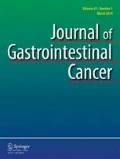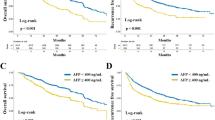Abstract
Purpose of the Study
Hepatocellular carcinoma (HCC) has tripled in incidence over the past 20 years and now ranks as the third leading cause of mortality attributed to cancer. Underlying pathophysiology is sustained hepatic inflammation which results in hepatocellular dysplasia and thus an environment prone to HCC. Considering the essential role of inflammation in the pathogenesis of HCC, we evaluated the prognostic utility of ferritin-transferrin ratio (FTR) in HCC.
Methods
We retrospectively reviewed the electronic medical records of patients with HCC (diagnosed on radiographic criteria and/or biopsy) from 2000 through 2015. We collected data regarding the patient demographics, laboratory investigations at the time of HCC diagnosis and prior to the initiation of treatment. Overall survival was calculated from the time of diagnosis, cases were censored at the date of last follow-up, if date of death was not known. Kaplan-Meier curves were estimated to evaluate the prognostic significance of FTR. Receiver operating characteristics (ROC) curve was plotted for FTR to predict mortality and identify cut-off value by optimized Youden’s index.
Results
Among the 176 patients identified by initial screening, 116 patients were eventually included for analysis. Overall median survival was 11.9 months. FTR, of note, was significantly lower in alive (6.9, p < 0.001). In univariate analysis, alfa-fetoprotein (AFP), aspartate aminotransferase (AST), serum ferritin (SF), transferrin (TFS), and FTR were significantly associated with mortality. On multivariate analysis for mortality, FTR, AFP, and epidemiologic factors predictive of mortality including male gender and advanced HCC were significant.
Conclusion
The ferritin-transferrin ratio (FTR), calculated at the time of HCC diagnosis could predict mortality in our cohort of patients. With an optimal cut-off of 7.7 for FTR were stratified into high- and low-risk groups. The hazard ratio between the two groups was 2.36 (p < 0.003). Future studies with longitudinal follow-up of FTR at intervals and important time points (e.g., perioperative) might provide more insights to its prognostic value.


Similar content being viewed by others
References
Waller LP, Deshpande V, Pyrsopoulos N. Hepatocellular carcinoma: a comprehensive review. World J Hepatol. 2015;7:2648–63. https://doi.org/10.4254/wjh.v7.i26.2648.
Cai J, Li B, Zhu Y, Fang X. Prognostic biomarker identification through integrating the gene signatures of hepatocellular Carcinoma properties. EBioMedicine. 2017;19:18–30. https://doi.org/10.1016/j.ebiom.2017.04.014.
Greten TF, Papendorf F, Bleck JS, Kirchhoff T, Wohlberedt T, Kubicka S, et al. Survival rate in patients with hepatocellular carcinoma: a retrospective analysis of 389 patients. Br J Cancer. 2005;92:1862–8. https://doi.org/10.1038/sj.bjc.6602590.
Villanueva A. Hepatocellular Carcinoma. NEJM. 2019;380:1450–62. https://doi.org/10.1056/NEJMc1906565.
Wang Y, Attar BM. Evaluation of the prognostic value of platelet to lymphocyte ratio in patients with hepatocellular carcinoma. J Gastrointest Oncol. 2017;8(6):1065–71. https://doi.org/10.21037/jgo.2017.09.06.
Gallo, et al. A new prognostic system for hepatocellular carcinoma: a retrospective study of 435 patients, the Cancer of the Liver Italian Program(CLIP)investigators. Hepatology. 1998;28(3):751–5. https://doi.org/10.21037/jgo.2017.09.06.
Llovet JM, Fuster J, Bruix J. Barcelona-Clínic Liver Cancer Group. The Barcelona approach: diagnosis, staging, and treatment of hepatocellular carcinoma. Liver Transpl. 2004;10(2 Suppl 1):115–20. https://doi.org/10.21037/jgo.2017.09.06.
Gauldie H, Richards J, Harnish C, Lansdorp D, Baumann P. Interferon beta 2/B-cell stimulatory factor type 2 shares identity with monocyte-derived hepatocyte-stimulating factor and regulates the major acute phase protein response in liver cells. Proc Natl Acad Sci U S A. 1987;84(20):7251–5. https://doi.org/10.1073/pnas.84.20.7251.
Kell DB, Pretorius E. Serum ferritin is an important inflammatory disease marker, as it is mainly a leakage product from damaged cells. Metallomics. 2014;6(4):748–73. https://doi.org/10.1039/c3mt00347g.
Ritchie RF, Palomaki GE, Neveux LM, et al. Reference distributions for the negative acute-phase serum proteins, albumin, transferrin and transthyretin: a practical, simple and clinically relevant approach in a large cohort. J Clin Lab Anal. 1999;13(6):273–9. https://doi.org/10.1002/(SICI)1098-2825(1999)13:6273:AID-JCL43.0.CO;2-X.
Castel R, Tax MG, Droogendijk J, Leers MP. The transferrin/log(ferritin) ratio: a new tool for the diagnosis of iron deficiency anemia. Clin Chem Lab Med. 2012;50(8):1343–9. https://doi.org/10.1515/cclm-2011-0594.
Wisniewski MF, Kieszkowski P, Zagorski BM, Trick WE, Sommers M, Weinstein RA. Development of a clinical data warehouse for hospital infection control. J Am Med Inform Assoc. 2003;10:454–62. https://doi.org/10.1197/jamia.M1299.
Najjar M, Agrawal S, Emond JC, Halazun KJ. Pretreatment neutrophil-lymphocyte ratio: useful prognostic biomarker in hepatocellular carcinoma. J Hepatocell Carcinoma. 2018;18(5):17–28. https://doi.org/10.2147/JHC.S86792.
Zidek JV, Wong H, Le N, Burnett R. Causality, measurement error and multicollinearity in epidemiology. Environmetrics. 1996;7:441–51. https://doi.org/10.1002/(SICI)1099-095X(199607)7:4<441::AID-ENV226>3.0.CO;2-V.
El-Serag HB, Rudolph KL. Hepatocellular carcinoma: epidemiology and molecular carcinogenesis. Gatsroenterology. 2007;132(7):2557–76. https://doi.org/10.1053/j.gastro.2007.04.061.
Sanyal AJ, Yoon SK, Lencioni R. The Etiology of Hepatocellular Carcinoma and Consequences for Treatment. Oncologist. 2010;15(Supplement 4):14–22. https://doi.org/10.1634/theoncologist.2010-S4-14.
Braicu C, Burz C, Berindan-Neagoe I, Carcinoma H. Tumorigenesis and prediction markers. Gastroenterology Res. 2009;2(4):191–9. https://doi.org/10.4021/gr2009.07.1304.
Whittington CA, Kowdley KV. Review article: haemochromatosis. Aliment Pharmacol Ther. 2002;16:1963–75. https://doi.org/10.1046/j.1365-2036.2002.01371.x.
Wang W, Knovich MA, Coffman LG. Serum ferritin: past, present and future. Biochim Biophys Acta. 2010;1800(8):760–9. https://doi.org/10.1016/j.bbagen.2010.03.011.
Vela D, Vela-Gaxha Z. Differential regulation of hepcidin in cancer and non-cancer tissues and its clinical implications. Exp Mol Med. 2018;50(2):e436. https://doi.org/10.1038/emm.2017.273.
O’Glasser AY, Scott DL, Corless CL, Zaman A, Sasaki A, Gopal DV, et al. Hepatic and cardiac iron overload among patients with end-stage liver disease referred for liver transplantation. Clin Transpl. 2009;24:643–51. https://doi.org/10.1111/j.1399-0012.2009.01136.x.
Cotler SJ, Bronner MP, Press RD, Carlson TH, Perkins JD, Emond MJ, et al. End-stage liver disease without hemochromatosis associated with elevated hepatic iron index. J Hepatol. 1998;29:257–62. https://doi.org/10.1016/s0168-8278(98)80011-1.
Hasuike Y, Nonoguchi H, Tokuyama M, Ohue M, Nagai T, Yahiro M, et al. Serum ferritin predicts prognosis in hemodialysis patients: the Nishinomiya study. Clin Exp Nephrol. 2010;14:349–55. https://doi.org/10.1007/s10157-010-0288-x.
Jehn M, Clark JM, Guallar E. Serum ferritin and risk of the metabolic syndrome in U.S. adults. Diabetes Care. 2004;27:2422–8. https://doi.org/10.2337/diacare.27.10.2442.
Kate J, Drenth JP, Kahn MF, van Deursen C. Iron saturation of serum ferritin in patients with adult onset Still’s disease. J Rheumatol. 2001;28:2213–5.
Franchini S, Dagna L, Salvo F, Aiello P, Baldissera E, Sabbadini MG. Adult onset Still’s disease: clinical presentation in a large cohort of Italian patients. Clin Exp Rheumatol. 2010;28:41–8.
Odabas AR, Karakuzu A, Cetinkaya R, Selcuk Y, Keles S, Bilen H. Increased serum ferritin levels in active Behcet’s disease. Int J Clin Pract. 2002;56:310–1.
Jenq CC, Hsu CW, Huang WH, Chen KH, Lin JL, Lin-Tan DT. Serum ferritin levels predict all-cause and infection-cause 1-year mortality in diabetic patients on maintenance hemodialysis. Am J Med Sci. 2009;337:188–94. https://doi.org/10.1097/MAJ.0b013e31818d8bbe.
Tunccan OG, Yegin ZA, Ozkurt ZN, Erbas G, Aki SZ, Senol E, et al. High ferritin levels are associated with hepatosplenic candidiasis in hematopoietic stem cell transplant candidates. Int J Infect Dis 2010. 2010;14(suppl 3):104–7. https://doi.org/10.1016/j.ijid.2009.11.028.
Cunha BA, Chak A, Strollo S. Fever of unknown origin (FUO): de Quervain’s subacute thyroiditis with highly elevated ferritin levels mimicking temporal arteritis (TA). Heart Lung. 2010;39:73–7. https://doi.org/10.1016/j.hrtlng.2009.06.006.
Facciorusso A, del Prete V, Antonino M, Neve V, Crucinio N, di Leo A, et al. Serum ferritin as a new prognostic factor in hepatocellular carcinoma patients treated with radiofrequency ablation. J Gastroenterol Hepatol. 2014;29:1905–10. https://doi.org/10.1111/jgh.12618.
Weismüller TJ, Kirchner GI, Scherer MN. Serum Ferritin Concentration and Transferrin Saturation Before Liver Transplantation Predict Decreased Long-Term Recipient Survival. Hepatology. 2011;54(6):2114–24. https://doi.org/10.1002/hep.24635.
Author information
Authors and Affiliations
Contributions
(I) Conception and design: Ishaan Vohra; (II) Administrative support: B Attar; (III) Provision of study materials or patients: Ishaan Vohra, Yuchen Wang, Pedro Palacios; (IV) Collection and assembly of data: Ishaan Vohra, Y Wang, Estefania Flores; (V) Data analysis and interpretation: Ishaan Vohra; (VI) Manuscript writing: Tejinder Randhawa and all other authors; (VII) Final approval of manuscript: All authors.
Corresponding author
Ethics declarations
Conflict of Interest
The authors declare that they have no conflicts of interest.
Ethical Statement
The present study was approved by the Institutional Review Board of Cook County Health & Hospitals System, Chicago (No. 19–128).
Additional information
Publisher’s Note
Springer Nature remains neutral with regard to jurisdictional claims in published maps and institutional affiliations.
This manuscript has not been published and is not under consideration for publication elsewhere. All authors have read the manuscript, declared no conflicts of interest and have approved this submission.
Rights and permissions
About this article
Cite this article
Vohra, I., Attar, B., Katiyar, V. et al. Evaluation of Ferritin and Transferrin Ratio as a Prognostic Marker for Hepatocellular Carcinoma. J Gastrointest Canc 52, 201–206 (2021). https://doi.org/10.1007/s12029-020-00373-4
Published:
Issue Date:
DOI: https://doi.org/10.1007/s12029-020-00373-4




